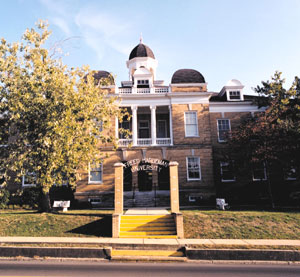
Freed-Hardeman University
Named in honor of former presidents A. G. Freed and N. B. Hardeman, Freed-Hardeman University in Henderson represents the culmination of a succession of private schools reaching back to 1869. It is affiliated with the Churches of Christ.
In 1907 the institution’s immediate forerunner, Georgie Robertson Christian College, closed for lack of funds because of a division in the supporting church. That same year Freed and Hardeman, both of whom were associated with the preceding institution (Freed as president and Hardeman as a student and afterward a teacher), were called upon by a group of local businessmen to head a school to be named the National Teachers’ Normal and Business College, with Freed as president and Hardeman as vice-president. In addition to their stature as educators, both were ministers of the Henderson Church of Christ and evangelists in the Churches of Christ.
Having assumed the mortgage on the school property, the two administrators in effect owned the institution. In 1919 they turned it over to a private board of trustees who were members of the Churches of Christ. The trustees renamed the school Freed-Hardeman College, a name it retained until 1990. It operated as a junior college from 1925 until 1975, when it began offering courses at a more advanced level.
Both Freed and Hardeman left the school in 1923; W. Claude Hall became president. Two years later Hardeman returned as associate president along with Hall C. Calhoun. The following year Calhoun left, and the board appointed Hardeman to the presidency, an office he occupied until his retirement in 1950. He was succeeded by H. A. Dixon, who, following his death in 1969, was succeeded by E. Claude Gardner. In 1990 Gardner retired as president and was succeeded by Milton R. Sewell, with Gardner becoming chancellor and later president emeritus. All of these men were ministers of the Churches of Christ.
Throughout its history the school has grown steadily both in the size of its faculty and student body and in the breadth and vitality of its programs. In 1976 Freed-Hardeman under President Gardner began offering the bachelor’s degree in a variety of fields; in 1989 it added graduate work in the areas of education and ministry. The following year, in conformity with its expanded endeavors, its name was changed to Freed-Hardeman University. In 1994, the institution added counseling and New Testament to its graduate curriculum.
Freed-Hardeman has traditionally sought to enhance in its students what it views as the elements of man’s nature: the spiritual, intellectual, social, and physical. It has drawn strength from the labors of a corps of dedicated and revered veteran faculty including, in addition to the administrators already named, such individuals as C. P. Roland (who in addition to his teaching, served for an extended period as dean and later as vice-president); the brothers L. L. and E. D. Brigance; W. Claude Hall (who returned in 1934 and remained for the rest of his career); Mary Nelle Powers (daughter of N. B. Hardeman); J. R. Ensley; and Robert Witt. Roland held the longest tenure of service and provided the clearest illustration of the institution’s extraordinary quality of continuity; he joined the faculty in 1921 and retired from the staff on July 4, 1983, his ninetieth birthday.



